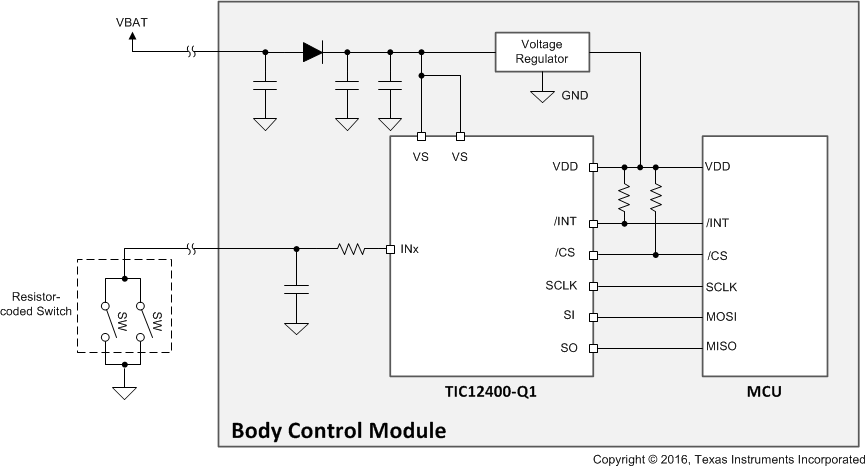JAJSDR6C August 2017 – February 2022 TIC12400-Q1
PRODUCTION DATA
- 1 特長
- 2 アプリケーション
- 3 概要
- 4 Revision History
- 5 Pin Configuration and Functions
- 6 Specifications
- 7 Parameter Measurement Information
-
8 Detailed Description
- 8.1 Overview
- 8.2 Functional Block Diagram
- 8.3
Feature Description
- 8.3.1 VS Pin
- 8.3.2 VDD Pin
- 8.3.3 Device Initialization
- 8.3.4 Device Trigger
- 8.3.5 Device Reset
- 8.3.6 VS Under-Voltage (UV) Condition
- 8.3.7 VS Over-Voltage (OV) Condition
- 8.3.8 Switch Inputs Settings
- 8.3.9 Interrupt Generation and INT Assertion
- 8.3.10 Temperature Monitor
- 8.3.11 Parity Check and Parity Generation
- 8.3.12 Cyclic Redundancy Check (CRC)
- 8.4 Device Functional Modes
- 8.5 Programming
- 8.6 Register Maps
- 8.7 Programming Guidelines
- 9 Application Information Disclaimer
- 10Power Supply Recommendations
- 11Layout
- 12Device and Documentation Support
- 13Mechanical, Packaging, and Orderable Information
パッケージ・オプション
メカニカル・データ(パッケージ|ピン)
- DCP|38
サーマルパッド・メカニカル・データ
- DCP|38
発注情報
9.3 Resistor-coded Switches Detection in Automotive Body Control Module
The body control module (BCM) is an electronic control unit responsible for monitoring and controlling various electronic accessories in a vehicle's body. Detection of various mechanical switches status in a vehicle is one important task handled by the BCM. Besides the typical on-and-off (or digital) type of switch, more sophisticated type of switches, called resistor-coded switches, can also be present in an automotive body control system.
Resistor-coded switches have more than 2 unique switch states, and are often used for implementation of wiper, illumination, and signal control arms in a vehicle. Due to various voltage potentials generated by different positions of a resistor-coded switch, an ADC, typically inside the microcontroller, is used to detect the different states of the switch. The TIC12400-Q1 can natively support monitoring of a resistor-coded switch with its integrated 10-bit ADC and configurable thresholds. The following application diagram depicts how the TIC12400-Q1 is used in a BCM to detect external mechanical resistor-coded switches and a detailed design example is shown in the following sections.
 Figure 9-5 Using TIC12400-Q1 to Monitor a Resistor-Coded Switch in Body Control Module Application
Figure 9-5 Using TIC12400-Q1 to Monitor a Resistor-Coded Switch in Body Control Module Application